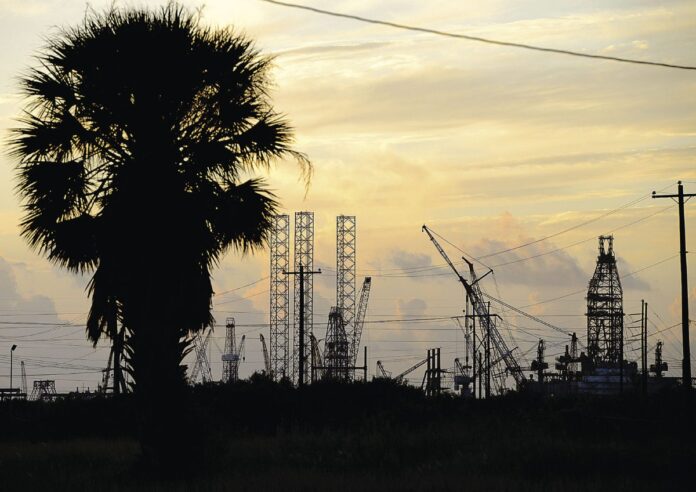Environmentalists won in their recent fight against liquefied natural gas in Oregon, and they believe they can win in Brownsville, too.
Getting a permit for an LNG plant is a long and expensive process. And as Oregon proved, it isn’t a sure thing.
The Federal Energy Regulatory Commission, the agency that grants permission for such facilities, denied Jordan Cove’s application to build an LNG export facility at Coos Bay, Oregon, in large measure because the applicants for the permit were unable to demonstrate that the benefits of such a facility outweighed the “potential for adverse impact on landowners and the communities,” FERC said in its denial issued in March.
In a 25-page order, the federal regulators based denial of a permit because the company seeking the permit “presented little or no evidence of need” for such a facility.
This was a shocking decision to all parties, including those fighting the facility. One Oregon resident, Jody McCaffree, who formed the advocacy group Citizen’s Against LNG, told The Oregonian that the decision gives some faith that “sometimes people can win with perseverance and hard work, even though you’re up against astronomical odds and deep pockets.”
And while environmentalists locally were heartened by the Oregon decision as a potential harbinger for denial in Brownsville, most observers concede the South Texas battle may be much tougher.
In Oregon, for example, a more populist anti-LNG sentiment laid the foundation for the FERC denial. The Brownsville proposal already has the backing of some powerful political figures, including Gov. Greg Abbott, who has said that an LNG facility will bring tremendous economic benefit to South Texas.
Langtry Meyer, who describes himself as an environmentalist, founded Texas Liquefied Natural Gas, which is deep into the filing process and, he hopes eventually, will win approval from the federal government to bring the giant facility to Brownsville.
Meyer’s priority is to avoid impact on the environment. If not avoid, then they’ll try to minimize, and if not minimize, mitigate, he said.
Then there are some like Rebekah Hinojosa, and those from the Sierra Club’s Lone Star Chapter, whose job is to make sure the LNG export terminal doesn’t make it to the Texas coast, at all.
Ocelots, and various birds could lose their homes, they contend. Wetlands and greenfields (undeveloped land) would be disturbed. Not to mention the giant facility, which Meyer said is relatively small compared to other U.S. LNG facilities, takes up a large swath of land.
“There’s no such thing as minimizing harm with wetlands and these endangered species,” said Jim Chapman, chairman of the Lower Rio Grande Valley Sierra Club.
Meyer said his group has conducted
300,000 hours of comprehensive study on the area and ensure LNG can have a proper home in Brownsville. FERC gives guidelines for those looking to get into LNG. Meyer said they’ve talked thoroughly with them all, including: The U.S. Fish and Wildlife Service, the Coast Guard, U.S. Army Corps of Engineers, Texas Parks and Wildlife.
“We’ve conducted
13 resource reports,” Meyer said. “Each of those reports analyzes the impacts on air, noise, visual impacts, fish, wildlife, vegetation, traffic, safety, reliability. They’re very extensive. We’ve spent tens of millions of
dollars.”
Then there’s the air pollution. The amount of emissions pumped into the atmosphere concerns many.
“These companies want to create an infrastructure for fossil fuels and this is a time when we need to turn away from that,” Chapman said. “But this would be a commitment for 30 years of fossil fuels.”
Meyer said natural gas is the cleanest fossil fuel and in a world where renewable energy is the safe and friendly route, Meyer doesn’t believe the world can survive on renewable energy alone.
“We’re not there yet. I hear it, but the logic doesn’t compute,” Meyer said. “If we shut down all fossil fuels, how would we operate this country’s energy requirements? And the world’s? What happens when the wind is not blowing? We need power. Certain parts of the world, there’s no hydro (for power). There’s not enough renewable energy to power the world’s needs. Natural gas is ideal to power the world’s needs.”
Susan Sakmar would take issue with an expert who says burning natural gas is clean. Sakmar is from San Francisco, has a license to practice law in California and has served on a number of nonprofit environmental boards.
She was interested in LNG and couldn’t find much out there, so “I wrote the book that I wish I found when I was researching,” Sakmar said. It’s called “Energy for the 21st Century: Opportunities and Challenges for Liquefied Natural Gas (LNG).”
Now she’s an Andrews Kurth Energy Law Scholar at the University of Houston Law Center where she focuses on global natural gas markets with a particular focus on LNG and global shale gas development.
For the rest of this story and many other EXTRAS, go to our premium site, www.MyValleyStar.com.
Subscribe to it for only $6.99 per month or purchase a print subscription and receive the online version free, which includes an electronic version of the full newspaper and extra photo galleries, links and other information you can’t find anywhere else.




